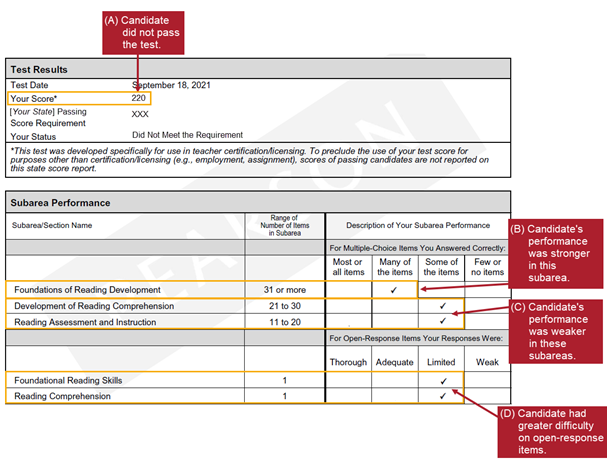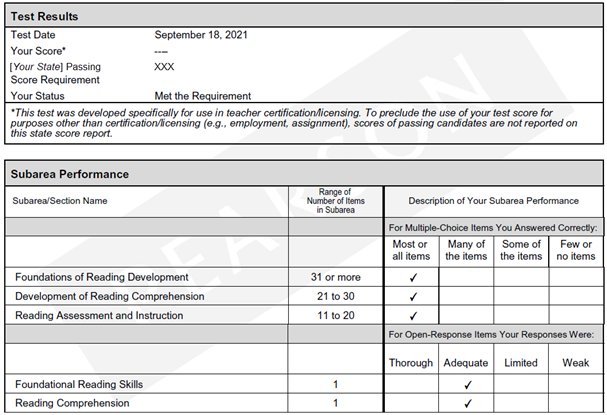- Home
- Faculty Resources
- Helping Candidates Interpret Their Test Results
Helping Candidates Interpret Their Test Results
The candidate score report provides information about candidate strengths and weaknesses relative to the knowledge or skills described by the test objectives.
- For multiple-choice items, performance information is provided for each subarea.
- Performance information is also provided for the open-response items.
Familiarize yourself with the sample score reports below. Also review the Score Report Explanation page. You can use that information to help candidates who are retaking a test understand how to use their score report in making their study plan.
Sample score reports: Foundations of Reading
The Foundations of Reading test contains multiple-choice items and open-response items, grouped into four subareas. The range of possible scaled scores is 100 to 300. The state passing score for each test can be found on the corresponding Test page.
Did not meet the qualifying score
There is a graphic of a sample score report with lettered red callouts that indicate pieces of information that will be referenced in the text that follows the graphic.
The title bar says Test Results. The next line has three pieces of information. They are Test Date: September 19, 2021. Your Score: 220. Passing Score Requirement: XXX. Your Status: Did Not Meet the Requirement Red callout A points to Your Score: 220 and says (A) Candidate did not pass the test.
Below this line is a table of the candidate's performance on the different sections of the test. There are six columns in the table. The heading of the first column is Subarea/Section Name. The heading of the second column is Range of Number of Items in Subarea. The remaining four columns are grouped under the heading Description of Your Subarea Performance. The headings of these four columns indicate the level of performance, and only one of these columns is checked for each Subarea. The three multiple-choice subareas are grouped together, followed by the open-response section.
I will now read the table.
Foundations of Reading Development. Range of Number of Items in Subarea, 31 or more. Description of Your Subarea Performance. For Multiple-Choice Items You Answered Correctly: Many of the items.
Development of Reading Comprehension. Range of Number of Items in Subarea, 21 to 30. Description of Your Subarea Performance. For Multiple-Choice Items You Answered Correctly: Some of the items.
Reading Assessment and Instruction. Range of Number of Items in Subarea, 11 to 20. Description of Your Subarea Performance. For Multiple-Choice Items You Answered Correctly: Some of the items.
Integration of Knowledge and Understanding. Range of Number of Items in Subarea, 2. Description of Your Subarea Performance. For Open-Response Items Your Responses Were: Limited.
Red callout B points to the checkmark for Foundations of Reading Development that indicates the candidate answered many of the items in this subarea correctly. The callout says (B) Candidate's performance was stronger in this subarea.
Red callout C points to the checkmarks for Development of Reading Comprehension and Reading Assessment and Instruction that indicate the candidate answered only some of the items in these subareas correctly. The callout says (C) Candidate's performance was weaker in these subareas.
Red callout D points to the checkmark for Integration of Knowledge and Understanding that indicates the candidate's open-response item responses were limited. The callout says (D) Candidate had greater difficulty on open-response items.
This sample score report shows that:
- the candidate did not pass (A), earning a scaled total test score of 220;
- performance in the subarea Foundations of Reading Development was relatively strong (B), but weaker performance on other subareas contributed to a failing score; and
- the candidate had greater difficulty in the subareas Development of Reading Comprehension and Reading Assessment and Instruction (C), as well as the open-response subareas Foundational Reading Skills and Reading Comprehension (D).
Advising this candidate
Based on the information in the score report, you might advise the candidate to:
- concentrate most heavily on the weaker areas;
- devote some additional studying to the stronger subarea, because improvement in any subarea will improve the total test score;
- review the open-response scoring rubric in the test information guide in conjunction with the score report, to identify specific areas for improvement; and
- do a self-check of the Test-Taking Strategies in section 2 of the Test Information Guide: for example, the candidate might consider, During my last test attempt, did I use the remaining test time to review my answers for accuracy?
Met the qualifying score
The sample score report below shows that this candidate:
- met the qualifying score on the Foundations of Reading test;
- did better in the subareas Development of Reading Comprehension and Reading Assessment and Instruction than in Foundations of Reading Development; and
- had Thorough and Adequate performances on the open-response items (Foundational Reading Skills and Reading Comprehension, respectively).
There is a graphic of a sample score report. This sample includes test name and date at the top, together with the candidate's identifying information.
The title bar says Test: 90 Foundations of Reading.
The next line has three pieces of information. They are Status: Met the Qualifying Score, Minimum Qualifying Score: 240, and Your Score:.
Below this line is a table of the candidate's performance on the different sections of the test. There are six columns in the table. The heading of the first column is Subarea/Section Name. The heading of the second column is Range of Number of Items in Subarea. The remaining four columns are grouped under the heading Description of Your Subarea Performance. The headings of these four columns indicate the level of performance, and only one of these columns is checked for each Subarea. The three multiple-choice subareas are grouped together, followed by the open-response section.
I will now read the table.
Foundations of Reading Development. Range of Number of Items in Subarea, 31 or more. Description of Your Subarea Performance. For Multiple-Choice Items You Answered Correctly: Some of the items.
Development of Reading Comprehension. Range of Number of Items in Subarea, 21 to 30. Description of Your Subarea Performance. For Multiple-Choice Items You Answered Correctly: Most or all items.
Reading Assessment and Instruction. Range of Number of Items in Subarea, 11 to 20. Description of Your Subarea Performance. For Multiple-Choice Items You Answered Correctly: Many of the items.
Integration of Knowledge and Understanding. Range of Number of Items in Subarea, 2. Description of Your Subarea Performance. For Open-Response Items Your Responses Were: Limited.
Below the table there is a rectangular grid of dots, and below that is the following text:
*Your Score: Scores for candidates who have met the qualifying score are not reported.
Cautions: Although examinees do not pass or fail individual test subareas/sections, the performance information above may be useful in understanding individual areas of strength and weakness. This information should be interpreted with caution since subareas/sections contain varying numbers of test items.
NOTE: Each test, like other licensure/certification tests, samples a broad base of content applicable in a wide range of educational settings, grade levels, and teaching assignments covered by the license. The tests are not designed as diagnostic tests, which would include substantially more questions necessary for making diagnostic decisions about individual candidates.
Need More Time?
To continue your session, select Stay Signed In.



